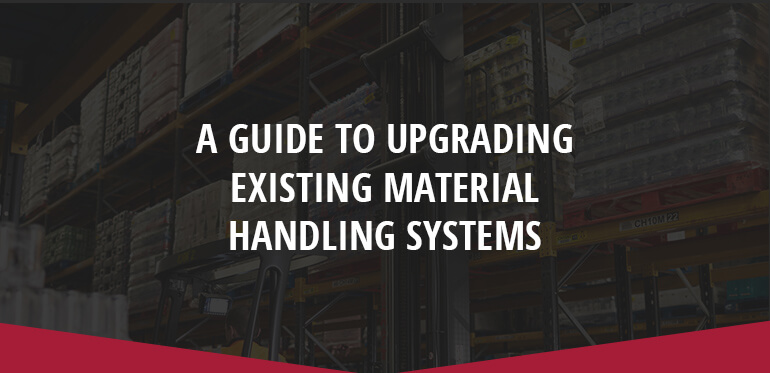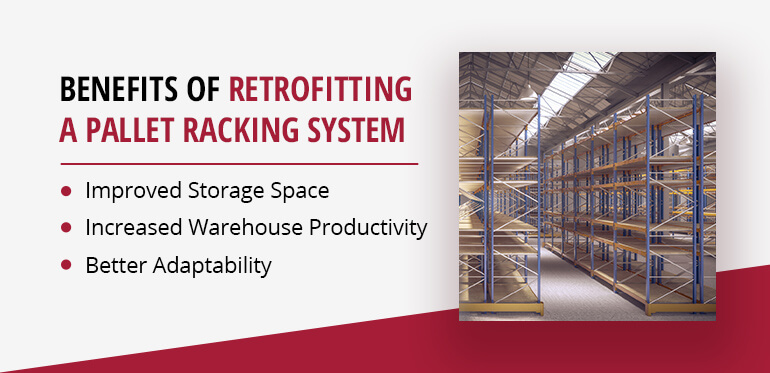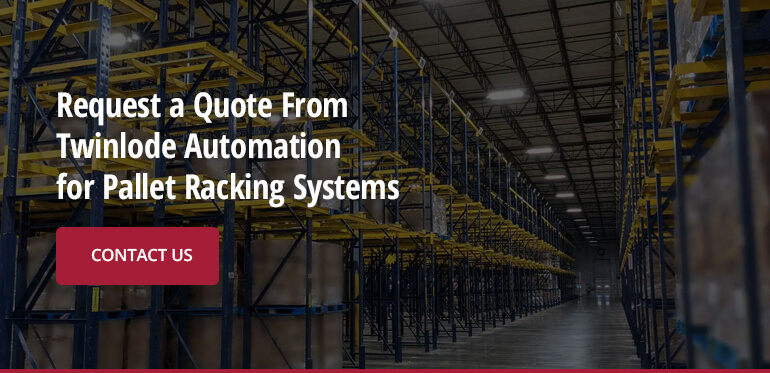
16 Mar A Guide to Upgrading Existing Material Handling Systems
Maximizing all available space is essential for maintaining peak productivity in a warehouse. Warehouse managers understand that to meet customer demands effectively and on time, facilities must utilize space efficiently for storage, retrieval, and order fulfillment by utilizing the best material handling system for the application.
Retrofitting or upgrading a material handling system may be one of the best solutions for making a warehouse’s space more efficient and suitable for current requirements. Along with enhancing operational efficiency, modifying pallet rack systems and upgrading existing material handling systems can improve the warehouse’s space utilization, product flow, and storage capacity.
Why Would a System Need Retrofitting or Upgrading?
There are several situations in which a pallet racking system or warehouse operation would need to be retrofitted. Here are some of the most common reasons why a warehouse could benefit from material handling equipment retrofits:
1. The Warehouse’s Needs Change
As the market changes and retailers make new demands, warehouse operations must adapt. The online shopping market is booming, pushing warehouses to handle an unprecedented product volume and variety. Improving layout, material flow, and material handling capabilities are mission-critical for warehouses aiming to not only survive, but also thrive in an ever-changing environment.
Outdated material handling systems cannot always handle new SKUs or meet the current market demands. Upgrading a material handling system allows warehouses to benefit from modern material handling equipment that effectively meets their changing needs.
2. A Warehouse Experiences Growth
As warehouses expand their operations, they outgrow their existing pallet racking systems and must adapt their processes to meet new goals and objectives. Growing into new markets and industries requires warehouses to optimize their operations to meet greater demand for throughput, storage capacity, and order fulfillment. If palletized loads are stored inefficiently, warehouses will struggle to house their increasing inventory volume.
Operations with high SKU counts must maximize warehouse layout and storage systems to accommodate their inventory. Changing SKU velocity also affects a warehouse’s operational needs. Optimizing material handling equipment for SKU velocity enables easier storage and picking for fast, medium, and slow-moving SKUs.
3. A Warehouse Uses New Technologies and Strategies
The technology and strategies a warehouse uses may change over time, prompting updates in the material handling system. The use of technology such as warehouse management systems (WMS), warehouse control systems (WCS), and manufacturing execution systems (MES) often requires new material handling equipment for the best results.
Supply chain strategies also impact the material handling system a warehouse implements. It is essential for a warehouse’s material handling equipment to align with its warehousing and inventory strategy. Additional challenges such as labor scarcity could increase the need for automation, motivating material handling equipment retrofits.
4. Material Handling Systems Are Damaged
Normal warehouse operations may sometimes cause damage to a warehouse’s existing material handling systems. Forklift collisions and overloaded frames can cause damage like dents, twisted metal, and bent anchors.
While these material handling equipment damages can sometimes be repaired, it is best to exercise caution. Damaged pallet racking systems or material handling equipment are inefficient and may pose a safety risk to personnel and operations. The best solution may be to upgrade or retrofit the material handling equipment to ensure it functions properly and is safe to use.
Benefits of Retrofitting a Pallet Racking System
Upgrading a warehouse’s existing material handling system can improve its operational efficiency by optimizing space and equipping the warehouse to meet changing needs. In particular, retrofitting a pallet racking system allows warehouses to improve productivity and remain flexible in a changing market. Other benefits include:
1. Improved Space Utilization
Unless a warehouse has the budget for building expansion or relocation, storage space is limited. It may not be cost-effective or efficient for a warehouse to overhaul its pallet racking system or construct a new building. Often, the best solution is to optimize the existing space. Material handling equipment retrofits are an effective way for warehouses to generate more storage capacity in the same building.
Retrofitting a pallet racking system provides greater floor utilization and increases storage space. A warehouse’s growth might require it to store and move a higher volume of inventory than the existing pallet racking system can manage, though taking on more orders is essential for such expansion.
Retrofitting existing pallet racking systems allows warehouses to handle a higher volume of pallets while working within the same space constraints. Professional installation of pallet racking components on existing racking systems can significantly increase storage density.
As an example, selective pallet racking allows for maximum SKU pick and efficient vertical pallet storage to optimize floor space. A pallet flow racking solution enables warehouses to store between two and 20 pallets deep, increasing storage density.
Retrofitting a pallet racking system to provide enhanced storage creates maximized inventory capacity and can aid a warehouse in its operational growth.
2. Increased Warehouse Productivity
Warehouses must achieve faster order fulfillment to reduce lead times. Productivity is essential for optimizing warehouse operations. Warehouse managers often look for ways to reduce inefficiencies and boost productivity. Whether an existing pallet racking system is outdated, damaged, or inefficient for the warehouse’s changing needs, retrofitting it with new components improves efficiency.
Retrofitting an existing pallet racking system with a more efficient solution allows warehouses to speed up order fulfillment and SKU picking during times of growth. Expanding a pallet racking system increases the warehouse’s inventory capacity, enabling greater efficiency and optimizing material flow.
The type of pallet racking system retrofit that is best suited for a warehouse depends on its needs, such as its inventory management methods. For instance, Drive In racking enables last-in, first-out inventory management and is ideal for warehouses without the space for two aisles for each rack. Further, pallet flow racking increases pick productivity by reducing the need for forklift operators to travel for load retrieval.
Modifying pallet racking may also improve productivity issues related to labor scarcity. One way warehouses improve productivity is by utilizing automation to supplement manual labor. Using automated layer picking increases order fulfillment speed and output by reducing the need for manual labor.
3. Better Adaptability
As market trends change, warehouses need the ability to adapt their processes to achieve success. Adapting is crucial for scaling business operations. Customer demand often ebbs and flows, though the rise of e-commerce has placed new demands on warehouses’ material handling capabilities. Warehouses entering new markets, increasing inventory, and adding new SKUs may require different pallet racking systems.
Warehouses need the flexibility to adapt as their inventory changes, which could involve retrofitting their material handling equipment with pallet racking systems designed for their inventory needs. For example, a warehouse entering the beer distribution business requires keg flow racking to accommodate keg storage. Warehouses that need high-density storage might implement push back racking, which enables storage of two to six pallets deep and easy access to a wide range of SKUs.
Warehouses can expand systems and automation to improve adaptability to different needs. Retrofitting a warehouse’s pallet racking system enables it to scale as its inventory increases and the business grows.
How to Retrofit a Pallet Racking System
Retrofitting a pallet racking system or warehouse operation is a multi-step process that involves examining a warehouse’s existing pallet racking system, identifying its operational goals, and determining which material handling solution bridges the gap. The following steps describe how the process works.
1. Identify Pain Points
Identifying the pain points or limitations of a warehouse’s existing pallet racking system is vital for determining a material handling solution that fills its requirements. These limitations or difficulties outline the warehouse’s greatest material handling needs. Some common pain points for warehouses include:
- Storage density
- Throughput
- Labor scarcity
- Inventory management
- Transportation of inventory between buildings
- Truck loading and unloading
- Reliance on manual processes
2. Outline Future Growth Initiatives
Once warehouse managers determine the operation’s pain points, the next step is drafting the warehouse’s future growth initiatives. Understanding its target markets and industries, storage capacity needs, and automation initiatives enables warehouses to identify solutions to achieve goals and scale operations.
3. Determine an Approximate Budget
Creating a budget for a pallet racking system upgrade is crucial. A warehouse’s storage and fulfillment costs must remain low enough so that it makes a profit. The budget for material handling equipment retrofits will range depending on each warehouse’s needs. If uncertain, a material handling expert will provide guidance.
4. Consult a Material Handling Expert to Find Solutions
Collaboration with a material handling expert enables warehouses to determine the right solution. These professionals will review any pain points and future growth initiatives to propose potential solutions. Thorough research on suppliers is crucial for verifying experience and reputation.
Request a Quote From Twinlode Automation for Pallet Racking Systems
Best-in-class material handling solutions from Twinlode Automation improve supply chain efficiency by increasing pick speed, improving space utilization, and enabling greater warehouse adaptability. For support on retrofitting an existing pallet racking solution, contact a representative.




